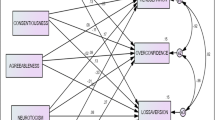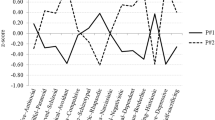Abstract
Adult participants (n = 224), mostly undergraduates, were randomly assigned to three major conditions representing three levels of textual errors (none, few, many). They read a text requesting financial assistance, then rated the writer on the Big Five personality traits (Openness, Conscientiousness, Extraversion, Agreeableness, Emotional Stability), and on three personality domains (Social Evaluation, Intellectual Evaluation, Potency). Finally, they judged the likelihood that the writer’s request would be granted, and gave reasons for their decision. Generally, textual errors created an overall negative impression, which was mainly accounted for by Conscientiousness. However, textual errors did not affect the financial judgments, which were predicted mainly by Conscientiousness and Intellectual Evaluation. Participants who cited writing errors in their reasons for their financial judgment gave a lower rating for the likelihood that the request would be honoured. For those who were more accurate at detecting errors, textual errors created a negative impression on the Big Five traits, accounted for by Conscientiousness, and on the three personality domains, accounted for by Intellectual Evaluation. There was also a negative effect of textual errors on the financial judgment, which was mediated mainly by Intellectual Evaluation. Theoretical and practical implications are discussed.
Similar content being viewed by others
Notes
We thank an anonymous reviewer for these suggestions.
References
American Psychological Association. (1992). Ethical principles of psychologists and code of conduct. American Psychologist, 47, 1597–1611.
Asch, S. E. (1946). Forming impressions of personality. Journal of Abnormal and Social Psychology, 41, 258–290. doi:10.1037/h0055756.
Beason, L. (2001). Ethos and error: How business people react to errors. College Composition and Communication, 33–64. doi:10.2307/359061.
Boland, J. E., & Queen, R. (2016). If You’re house is still available, send me an email: Personality influences reactions to written errors in email messages. PloS One, 11(3). doi:10.1371/journal.pone.0149885.
Borkenau, P. (1992). Implicit personality theory and the five-factor model. Journal of Personality, 60, 295–327. doi:10.1111/j.1467-6494.1992.tb00975.x.
Caldwell, D. F., & Burger, J. M. (1998). Personality characteristics of job applicants and success in screening interviews. Personnel Psychology, 51, 119–136. doi:10.1111/j.1744-6570.1998.tb00718.x.
Chaney, L. H., & Martin, H. S. (2007). The essential guide to business etiquette. Westport, CT: Praeger.
Cohen, J. (1977). Statistical power analysis for the behavioral sciences (rev. ed.). New York: Academic Press.
Cole, M. S., Feild, H. S., & Stafford, J. O. (2005). Validity of resume reviewers’ inferences concerning applicant personality based on resume evaluation. International Journal of Selection and Assessment, 13, 321–324. doi:10.1111/j.1468-2389.2005.00329.x.
Damhorst, M. L. (1990). In search of a common thread: Classification of information communicated through dress. Clothing and Textiles Research Journal, 8, 1–12. doi:10.1177/0887302X9000800201.
De Groot, T., & Gooty, J. (2009). Can nonverbal cues be used to make meaningful personality attributions in employment interviews? Journal of Business and Psychology, 24, 179–192. doi:10.1007/s10869-009-9098-0.
de Vries, R. E. (2011). No evidence for a general factor of personality in the HEXACO personality inventory. Journal of Research in Personality, 34, 229–232. doi:10.1016/j.jrp.2010.12.002.
DeYoung, C. G., Quilty, L. C., Peterson, J. B., & Gray, J. R. (2014). Openness to experience, intellect, and cognitive ability. Journal of Personality Assessment, 96, 46–52. doi:10.1080/00223891.2013.806327.
Figueredo, L., & Varnhagen, C. K. (2005). Didn’t you run the spell checker? Effects of type of spelling error and use of a spell checker on perceptions of the author. Reading Psychology, 26, 441–458. doi:10.1080/02702710500400495.
Furnham, A., Chamorro-Premuzic, T., & Callahan, I. (2003). Does graphology predict personality and intelligence? Individual Differences Research, 1, 78–94.
Gill, A., & Oberlander, J. (2003). Perception of email personality at zero acquaintance: Extraver- sion takes care of itself; Neuroticism is a worry. Proceedings of the 25th Annual Conference of the Cognitive Science Society (pp. 456–461). Hills- dale, NJ: Lawrence Erlbaum Associates.
Goldberg, L. R., Johnson, J. A., Eber, H. W., Hogan, R., Ashton, M. C., Cloninger, C. R., & Gough, H. C. (2006). The International personality Item Pool and the future of public-domain personality measures. Journal of Research in Personality, 40, 84–96. doi:10.1016/j.jrp.2005.08.007.
Gosling, S. D., Rentfrow, P. J., & Jr, S. (2003). A very brief measure of the big-five personality domains. Journal of Research in Personality, 37, 504–528. doi:10.1016/S0092-6566(03)00046-1.
Gow, A. J., Whiteman, M. C., Pattie, A., & Deary, I, J, (2005). Goldberg’s ‘IPIP’ big-five factor markers: Internal consistency and concurrent validation in Scotland. Personality and Individual Differences, 39, 317–329. doi:10.1016/j.paid.2005.01.011
Graham, L. T., & Gosling, S. D. (2012). Impressions of world of Warcraft players’ personalities based on their usernames: Interobserver consensus but no accuracy. Journal of Research in Personality, 46, 599–603. doi:10.1016/j.jrp.2012.05.002.
Hancock, J. T., & Dunham, P. J. (2001). Impression formation in computer-mediated communication revisited: An analysis of the breadth and intensity of impressions. Communication Research, 28, 325–347. doi:10.1177/009365001028003004.
Hoover, B. (2013). Good grammar should be everyone’s business. Harvard Business Review: HBR Blog Network https://hbr.org/2013/03/good-grammar-should-be-everyon.
Huck, G. J. (2015). What is good writing? New York: Oxford University Press. doi:10.1093/acprof:oso/9780190212957.001.0001.
International Personality Item Pool (2017) A scientific Collaboratory for the development of advanced measures of personality traits and other individual differences (http://Ipip.Ori.Org/). Internet Web Site.
Jessmer, S. L., & Anderson, D. (2001). The effect of politeness and grammar on user perceptions of electronic mail. North American Journal of Psychology, 3, 331–346.
Kreiner, D. S., Schnakenberg, S. D., Green, A. G., Costello, M. J., & McClin, A. F. (2002). Effects of spelling errors on the perception of writers. Journal of General Psychology, 129, 5–17. doi:10.1080/00221300209602029.
Langlois, J. H., Kalakanis, L., Rubenstein, A. J., Larson, A., Hallam, M., & Smoot, M. (2000). Maxims or myths of beauty? A meta-analytic and theoretical review. Psychological Bulletin, 126, 390. doi:10.1037/0033-2909.126.3.390.
Mairesse, F., Walker, M. A., Mehl, M. R., & Moore, R. K. (2007). Using linguistic cues for the automatic recognition of personality in conversation and text. Journal of Artificial Intelligence Research, 30, 457–500. doi:10.1613/jair.2349.
McAleer, P., Todorov, A., & Belin, P. (2014). How do you say “hello”? Personality impressions from brief novel voices. PloS One, 9(3), e90779. doi:10.1371/journal.pone.0090779.
McCrae, R. R., & Costa Jr., P. T. (2008). Empirical and theoretical status of the five-factor model of personality traits. In G. J. Boyle, G. Matthews, & D. H. Saklofske (Eds.), The sage handbook of personality theory and assessment, Personality measurement and testing (Vol. 2, pp. 179–198). Thousand Oaks, CA: Sage Publications. doi:10.4135/9781849200462.n13.
Mook, D. G. (1983). In defense of external invalidity. American Psychologist, 38, 370–387. doi:10.1037/0003-066X.38.4.379.
Musek, J. (2007). A general factor of personality: Evidence for the big one in the five-factor model. Journal of Research in Personality, 41, 1214–1233. doi:10.1016/j.jrp.2007.02.003.
Nisbett, R. E., & Wilson, T. D. (1977). The halo effect: Evidence for unconscious alteration of judgments. Journal of Personality and Social Psychology, 35, 250–256. doi:10.1037/0022-3514.35.4.250.
Rushton, J. P., & Irwing, P. (2011). The general factor of personality: Normal and abnormal. In T. Chamorro-Premuzic, S. von Stumm, & A. Furnham (Eds.), The Wiley-Blackwell Handbook of Individual Differences (1 st ed.) (pp. 132–161). Blackwell Publishing Ltd..
Stiff, C. (2012). Watch what you write: How errors in feedback influence reputations, spending behaviour, and trust towards buyers and sellers on ecommerce websites. Journal of Internet Commerce, 11, 41–67. doi:10.1080/15332861.2012.650988.
Tabachnick, B. G., & Fidell, L. S. (1996). Using multivariate statistics (3rd ed.). New York: Harper Collins.
Tri-Council Policy Statement: Ethical conduct for research involving humans. Medical Research Council of Canada, Natural Sciences and Engineering Research Council of Canada and Social Sciences and Humanities Research Council of Canada. Ottawa: Ontario Public Works and Government. (1998). Available at: http://pre.ethics.gc.ca/eng/policy-politique/initiatives/tcps2-eptc2/Default/ Accessed March 30, 2011.
Uleman, J. S., & Kressel, L. M. (2013). A brief history of theory and research on impression formation. In D. Calston (Ed.), Oxford handbook of social cognition (pp. 53–73). Oxford: Oxford University Press. doi:10.1093/oxfordhb/9780199730018.013.0004.
van der Linden, D., te Nijenhis, J., & Bakker, A. B. (2010). The general factor of personality: A meta-analysis of big five intercorrelations and a criterion-related validity study. Journal of Research in Personality, 44, 315–327. doi:10.1016/j.jrp.2010.03.003.
Vazire, S., & Gosling, S. D. (2004). E-perceptions: Personality impressions based on personal websites. Journal of Personality and Social Psychology, 87, 123. doi:10.1037/0022-3514.87.1.123
Vignovic, J. A., & Thompson, L. F. (2010). Computer-mediated cross-cultural collaboration: Attributing communication errors to the person versus the situation. Journal of Applied Psychology, 95, 265–276. doi:10.1037/a0018628.
Warner, R. M., & Sugarman, D. B. (1986). Attributions of personality based on physical appearance, speech, and handwriting. Journal of Personality and Social Psychology, 50, 792–799. doi:10.1037/0022-3514.50.4.792.
Ypofanti, M., Zisi, V., Zourbanos, N., Mouchtouri, B., Tzanne, P., Theodorakis, Y., & Lyrakos, G. (2015). Psychometric properties of the International personality Item Pool big-five personality questionnaire for the Greek population. Health Psychology Research, 3(2206), 41–47. doi:10.4081/hpr.2015.2206.
Zheng, L., Goldberg, L. R., Zheng, Y., Zhao, Y., Tang, Y., & Liu, L. (2008). Reliability and concurrent validation of the IPIP big-five factor markers in China: Consistencies in factor structure between internet-obtained heterosexual and homosexual samples. Personality and Individual Differences, 45, 649–654. doi:10.1016/j.paid.2008.07.009.
Author information
Authors and Affiliations
Corresponding author
Ethics declarations
Ethical Approval
This experiment was conducted with human participants. All procedures were performed in accordance with the ethical standards of the institution and of the Canadian Tri-Council Statement on Ethical Conduct for Research involving Human Participants (TCPS2), 1998.
Conflict of Interest
Elizabeth Morin-Lessard declares that she has no conflict of interest.
Stuart J. McKelvie declares that he has no conflict of interest.
Rights and permissions
About this article
Cite this article
Morin-Lessard, E., McKelvie, S.J. Does Writeing Rite Matter? Effects of Textual Errors on Personality Trait Attributions. Curr Psychol 38, 21–32 (2019). https://doi.org/10.1007/s12144-017-9582-z
Published:
Issue Date:
DOI: https://doi.org/10.1007/s12144-017-9582-z




